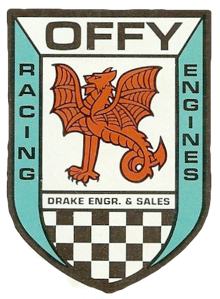Offenhauser
 |
|
| Industry | Automotive |
|---|---|
| Founded | 1933 |
| Founder | Fred H. Offenhauser and |
| Products | Racing engines |
The Offy or Offenhauser Racing Engine is a racing engine design that dominated American open wheel racing for more than 50 years and is still popular among vintage sprint and midget car racers.
The Offenhauser engine, familiarly known as the "Offy", was developed by Fred Offenhauser and his employer Harry Arminius Miller. Originally, it was sold as a marine engine. In 1930, a four-cylinder 151 cu in (2.47 l) Miller engine installed in a race car set a new international land speed record of 144.895 mph (233.186 km/h). Miller developed this engine into a twin overhead cam, four-cylinder, four-valve-per-cylinder 220 cu in (3.6 l) racing engine. Variations of this design would be used in midgets and sprints into the 1960s, with a choice of carburetion or Hilborn fuel injection. When both Miller and the company to whom he had sold much of the equipment and rights went bankrupt in 1933, Offenhauser opened a shop a block away and bought rights to engines, special tooling and drawings at the bankruptcy auction, and he and other former Miller employees took over production. They and former Miller employee, draftsman Leo Goossen, further developed the Miller engines into the Offenhauser engines. Then in 1946 the name and engine designs were sold to Louis Meyer and Dale Drake. Meyer was bought out by Drake, his wife Eve and their son John in 1965. From then until Drake's son John sold the shop to Stewart Van Dyne, the Drake family designed and refined the engine until its final race days. It was under Meyer and Drake that the engine dominated the Indy 500 and midget racing in the United States.
One of the keys to the Offenhauser engine's success and popularity was its power. A 251.92 cubic inch (4,128.29 cm³) DOHC four-cylinder racing Offy with a 15:1 compression ratio and a 4.28125-by-4.375-inch (108.744 mm × 111.125 mm) bore and stroke, could produce 420 hp (310 kW) at 6,600 rpm (1.77 hp per cubic inch (81 kW/L). Other variants of the engine produced even higher outputs of 3 hp per cubic inch (137 kW/L). Another reason for the engine's success was its reliability; its monobloc construction meant it was not vulnerable to head gasket or cylinder stud problems, and allowed for higher cylinder pressures.
...
Wikipedia
